Charoite Cabochons: Discover Their Beauty and Value
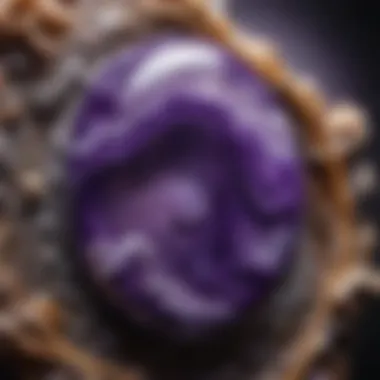
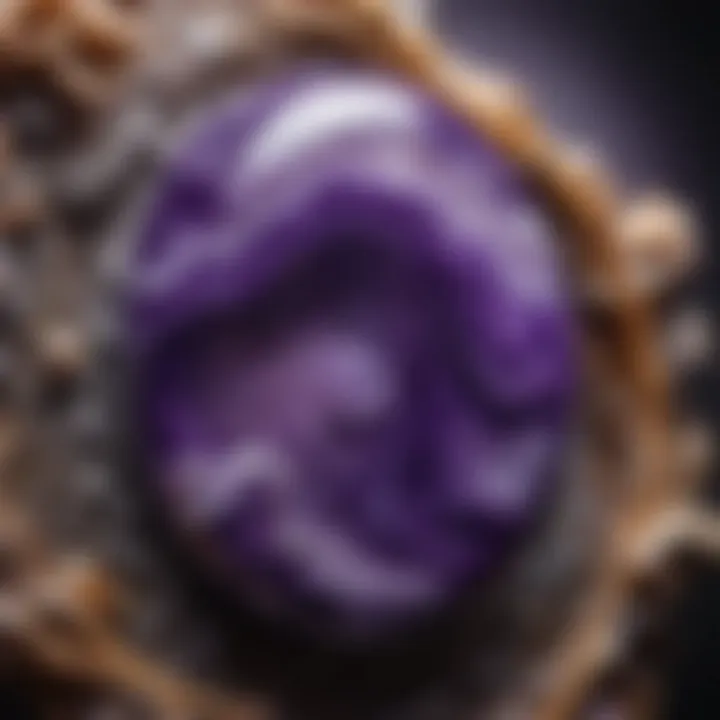
Intro
Charoite cabochons are fascinating specimens that hold a special place in the hearts of mineral collectors and enthusiasts alike. Originating from a specific geological formation, charoite captivates with its vivid purple hues and swirling patterns. Understanding charoite requires more than just an appreciation for its beauty; it involves a dive into its unique characteristics, origins, and the nuances of collecting this remarkable mineral. Whether you are a seasoned collector or just starting out, this guide aims to provide you with valuable insights into charoite cabochons, enhancing your knowledge and appreciation of this exquisite mineral.
Featured Collectible of the Month
Overview
Charoite has emerged as a noteworthy collectible among rock and mineral enthusiasts. This striking mineral, primarily found in Siberia, Russia, is known for its distinct purple coloration and complex patterns. The rarity of charoite contributes significantly to its value in the collector's market. Often crafted into cabochons for use in jewelry or display, charoite offers both aesthetic appeal and investment potential.
Historical Significance
Discovered relatively recently in the 1940s, charoite has a brief but intriguing history. Its unique properties were not recognized until studies conducted in the 1970s began to unveil its geological formation. As a result, the mineral has gained popularity not only for its beauty but also for its rarity. Charoite is often associated with specific places like the Chara River in Siberia, contributing to its allure in the collector community. Its distinct characteristics have made it a topic of interest across various fields, including geology, jewelry design, and mineralogy.
Identification Techniques
Visual Characteristics
Identifying charoite cabochons requires keen observation. The mineral is typically recognized by its vibrant purple coloration, which can range from light lavender to deep violet. Other notable features include:
- Unique swirling patterns of white, black, and lilac.
- A glassy luster that enhances its visual appeal.
- Transparency that can vary from opaque to slightly translucent.
When inspecting a charoite cabochon, look for these distinctive patterns and colors, as they are key identifiers that set charoite apart from other similar minerals.
Resources for Identification
To further assist in identifying charoite, several resources are available:
- Gem and Mineral Organizations: Many provide detailed guides on mineral identification.
- Online Forums: Websites like Reddit and Facebook host communities where experienced collectors share insights and photographs for comparison.
- Books on Mineralogy: Reference texts often include descriptions and images, aiding in visual identification.
Also, utilizing trusted online encyclopedias such as Wikipedia and Britannica can offer additional information on charoite's properties and identification methods.
Charoite is not only a beautiful mineral; its unique formation process and the specific locations where it is found contribute significantly to its desirability as a collectible.
Foreword to Charoite Cabochons
Charoite cabochons represent a unique segment within the realm of mineral collecting. Their captivating colors and intricate patterns not only draw the eye but also hold significant value for collectors. This section serves to establish a foundational understanding of charoite cabochons, elaborating on their characteristics and highlighting what makes them a distinct focus in gemstone collecting.
Defining Charoite
Charoite is a rare mineral that was first discovered in the late 1940s in Siberia, Russia. Its distinctive purple hues often display swirling patterns of white, black, or gray. Althoughthe mineral's composition primarily includes silicate, its unique formation process adds to its complexity. The name "charoite" is derived from the nearby Chara River, emphasizing its geographic origins. The rarity of charoite can increase its desirability among collectors, contributing to both its uniqueness and market value.
The combination of colors and swirling patterns found in charoite arises from the presence of multiple minerals, including calcite, leucite, and mica. This mineral blend ultimately leads to the characteristic aesthetic appeal associated with charoite. Thus, understanding the definition and properties of charoite is essential for any collector interested in this mineral.
The Allure of Cabochons
Cabochons are polished gemstones that present a smooth, rounded surface, which enhances the visual appeal of the stone. The allure of cabochons lies in their ability to showcase a mineral's internal features and colors. In the case of charoite, the cabochon style allows for the highlighting of its vibrant purples and complex patterns.
One significant aspect of cabochons is how they are cut. The shape and finish can dramatically affect a stone's overall look and, consequently, its market value. Collectors often seek out cabochons that display dynamic patterns and vivid colors, particularly with charoite. The smooth surface of a cabochon also provides an inviting tactile experience, increasing its desirability among potential buyers.
The craftsmanship involved in creating charoite cabochons further elevates their appeal, as skilled artisans can transform raw pieces into stunning works of art.
Furthermore, the versatility of cabochons extends beyond mere aesthetics. They are utilized in various applications, including jewelry, decorative art, and even healing practices. As charoite continues to gain recognition, its cabochon forms become more prominent in collecting circles. This rise in popularity highlights the importance of understanding both the properties and the cultural significance of charoite cabochons, especially among enthusiasts looking to expand their collections.
Geological Formation of Charoite
The geological formation of charoite is a critical aspect of understanding this unique mineral. It provides insights into how this stone came into existence and why it holds such value among collectors. Charoite is primarily found in a specific region of Siberia, Russia. The conditions of its formation are crucial since they define the unique characteristics the cabochons exhibit. This section aims to explore these origins deeply, giving readers an understanding of how geological processes shape not only the look but also the value of charoite cabochons.
The Origins of Charoite
Charoite was first discovered in the 1940s near the Charo River in Siberia. It is a rare mineral that forms primarily from the metamorphism of volcanic rocks. This metamorphic process occurs under extreme pressure and temperature conditions, which lead to the formation of charoite in a localized area.
The unique purple hues and striking patterns derive from its composition and the presence of other minerals during its formation. In addition to being aesthetically appealing, these geological origins also play a role in the mineral's scarcity. Since charoite is found mainly in Russia, its geographic limitations add to its appeal as a collectible. This rarity often elevates its status within both mineral and gem collections.
"Understanding the origins of charoite enhances the appreciation of each unique cabochon."
Mineral Composition and Structure
Charoite is primarily composed of silicate minerals, primarily rearranged from pre-existing materials. Its key components include potassium, sodium, calcium, and barium. Additionally, the mineral features inclusions that can be made up of other materials like quartz or calcite. This composite structure contributes to the vibrant color variations seen in charoite cabochons, ranging from deep purples to lighter shades with creamy white streaks.
The unique fibrous structure of charoite allows for some interesting optical effects. It reflects light in a way that can display a stunning chatoyant quality, enhancing its desirability among collectors. The mineral’s hardness, rated between 5 to 6 on the Mohs scale, means it is durable enough for various applications, yet it remains susceptible to scratches and damage if not cared for properly.
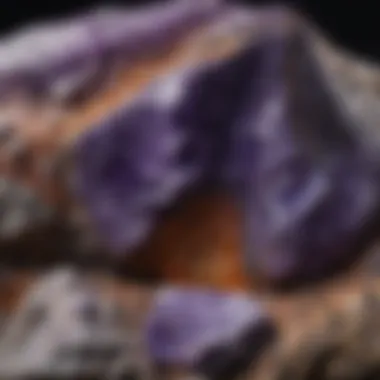
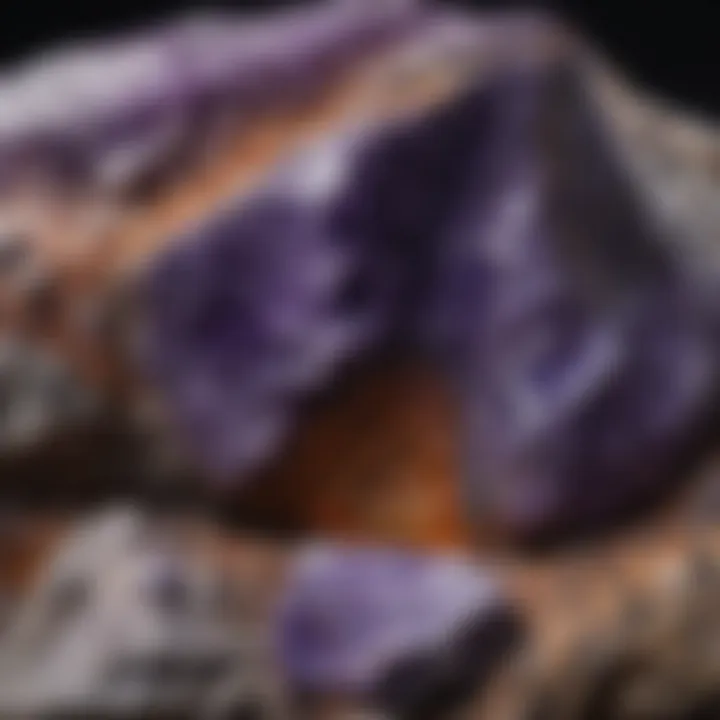
In summary, the geological formation of charoite provides a foundation for its characteristics and collecting insights. Understanding its origins and mineral structure not only aids in identification but also offers a deeper appreciation for this remarkable mineral.
Properties of Charoite Cabochons
The properties of charoite cabochons are essential to understanding their appeal and value among collectors and enthusiasts. This section aims to delve deeply into the physical attributes and optical phenomenon that define charoite. By comprehending these characteristics, collectors can make informed decisions when acquiring and care for these cabochons.
Physical Properties
Color Variations
One of the most striking aspects of charoite is its diverse color variations. Charoite typically exhibits purples, lavenders, and lilacs, often interspersed with white, black, and shades of blue. This vast spectrum makes charoite quite popular among collectors because each piece is unique. The vivid colors arise from the mineral composition, where the presence of trace elements creates various shades.
Key characteristic here is the intensity and depth of the colors. More vibrant pieces often fetch higher prices because they stand out better in displays or jewelry settings.
However, potential downsides include the inconsistency in color, where some pieces may appear more muted or dull. Collectors should understand that individual taste plays a significant role in what makes a piece desirable.
Transparency
Transparency in charoite cabochons ranges from opaque to translucent. Several collectors prefer translucent pieces as they tend to exhibit more depth and visual intrigue. The play of light in translucent cabochons can enhance their overall beauty. This characteristic not only adds to the aesthetic value but also gives insight into how light interacts with the stone.
A unique feature of charoite is that its level of transparency can affect pricing. Generally, the more translucent a piece is, the more likely it is sought after by collectors. However, opaque pieces can do well in specific settings, especially when used in unique designs and artistic expressions.
Hardness
The hardness of charoite typically falls between 5 and 6 on the Mohs scale. This means it is relatively soft compared to other gems like sapphire or diamond. This characteristic is crucial for collectors and jewelers alike.
A beneficial aspect of charoite’s hardness is that it allows for easier shaping into cabochons, enhancing its use in jewelry. However, this softness also requires careful handling to prevent scratches or damage. Collectors must be judicious in how they display and use charoite to maintain its pristine condition.
Optical Phenomena
Chatoyancy
Chatoyancy, or the "cat's eye" effect, is notably present in some charoite cabochons. This phenomenon reflects light in a way that creates a narrow band of brightness across the surface of the gemstone. The presence of fibrous inclusions within the stone is what causes this striking effect.
Collectors value charoite with pronounced chatoyancy because it adds another level of visual appeal, making each piece more enchanting. However, such pieces are rarer and might require collectors to pay a premium.
Asterism
Asterism, or the star effect, occurs when light reflects off multiple inclusions within the stone, creating a star-like pattern on its surface. While asterism is less commonly seen in charoite than in some other gemstones, it significantly enhances the visual impact when visible.
The presence of asterism in charoite makes these cabochons quite sought after. However, again, the rarity implies that collectors may need to invest substantially for such a piece.
Understanding the properties of charoite cabochons is critical for appreciation and investment. Their color, transparency, hardness, and optical phenomena considerably influence their overall appeal.
Collecting Charoite Cabochons
Collecting charoite cabochons offers a unique experience for enthusiasts and collectors alike. The appeal lies not only in the vibrant colors and patterns of charoite but also its geological rarity. This mineral, found primarily in Russia, captures the fascination of those intrigued by natural beauty. Collectors appreciate charoite for its distinctive appearance and the stories behind each piece. It is essential for collectors to understand the various aspects related to this mineral to enhance their collection.
Why Collect Charoite Cabochons?
The reasons to collect charoite cabochons are numerous. First, their aesthetic value is undeniable. The swirling purples, blacks, and whites create a mesmerizing visual that adds depth to any collection. Second, the rarity of charoite enhances its value as a collectible mineral. As fewer deposits become accessible, owning authentic pieces becomes increasingly significant.
Additionally, charoite is not just a beautiful stone; it’s also rich with history and geological intrigue. Understanding its origin adds an element of appreciation for collectors. Furthermore, being part of a community that values such unique specimens can create a sense of belonging among collectors.
Identifying Authentic Charoite
To ensure a valuable collection, identifying authentic charoite is critical. Counterfeits can mislead even experienced collectors. Knowing what characteristics to look for can help differentiate between genuine and fake stones.
Common Counterfeits
Among common counterfeits of charoite, dyed quartz and synthetic materials are prevalent. These alternatives might mimic the colors but lack the depth and complexity of authentic charoite. An essential characteristic of dyed quartz is its uniformity in color, which is not typical for natural stones. Collectors should be aware of this trait when evaluating a stone.
It is worth noting that some sellers might not disclose that these stones are not genuine charoite. This can lead to a loss of investment for collectors wanting true specimens in their collection. Understanding these counterfeits and recognizing their distinct features is paramount.
Testing Techniques
Employing testing techniques can further aid collectors in verifying authenticity. One common method involves the use of a refractometer to measure the stone's refractive index. Authentic charoite typically has a unique index value that can set it apart from imitations.
Another effective testing technique is the scratch test. Charoite has specific hardness levels that can offer insights during evaluation. Collectors should be cautious about using methods that could damage the stone. The advantages of these techniques lie in their reliability in distinguishing true charoite from counterfeits.
Understanding the nature of charoite and its potential counterfeits is vital for any serious collector. Knowledge empowers collectors to make informed decisions.
By employing careful observation and reliable testing methods, collectors can confidently enhance their charoite cabochon collections while minimizing the risk of acquiring fakes.
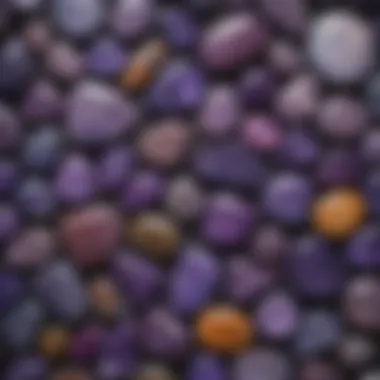

Caring for Charoite Cabochons
Caring for Charoite cabochons is essential for maintaining their beauty and integrity. This delicate mineral can be susceptible to damage if not handled properly. Understanding the right cleaning methods and storage tips can help preserve its vibrancy and prevent deterioration over time.
Cleaning Methods
Charoite requires gentle cleaning to protect its surface. Here are some effective cleaning methods:
- Soft Cloth: Use a clean, soft cloth to wipe down the stone regularly. This removes dust and grime without scratching its surface.
- Mild Soap and Water: For deeper cleaning, mix a few drops of mild soap with lukewarm water. Dip a soft cloth into this solution, wring it out, and gently clean the cabochon. Avoid using acidic cleaners, as they can damage the stone.
- Avoid Harsh Chemicals: Stay away from abrasive cleaners or products containing bleach. Such substances can cause irreparable harm to charoite’s surface.
It is also wise to clean charoite cabochons after wearing them, as oils from the skin can affect their appearance.
Storage Tips
Proper storage is key to protecting Charoite cabochons from damage. Here are some helpful storage tips:
- Individual Pouches: Store each cabochon in a separate soft pouch or wrap. This prevents scratching from contact with other stones.
- Avoid Direct Sunlight: Keep the cabochons in a dark or shaded area to avoid fading caused by prolonged exposure to sunlight.
- Temperature Considerations: Store at moderate temperatures. Extreme fluctuations can lead to cracks or other damage.
- Use a Jewelry Box: If you have multiple pieces, consider using a dedicated jewelry box lined with soft fabric. This protects the stones while keeping them organized.
Charoite in Jewelry Making
Charoite holds significant value in the realm of jewelry making. Its unique beauty and remarkable properties make it an attractive choice for artisans and collectors alike. The vibrant hues and distinct patterns found in charoite can transform simple jewelry pieces into striking works of art. Moreover, charoite’s rarity elevates its status, as fewer pieces are available than more common gemstones, thus appealing to those seeking exclusivity in their collections.
Common Applications
Charoite is versatile, and its applications in jewelry extend across various styles and designs. It is often used in:
- Cabochons: Smooth, polished stones that are typically used in pendants or rings.
- Beaded Jewelry: The unique colors and patterns lend themselves well to necklaces and bracelets.
- Inlays: Artisans incorporate charoite into decorative furniture or other functional pieces.
- Earrings: Lightweight and visually stunning, making them popular for statement pieces.
These applications underscore charoite’s flexibility. Each piece often showcases the mineral's natural variations, ensuring that no two items are exactly alike.
Design Considerations
When designing jewelry with charoite, several key considerations can enhance the final product:
- Color Palette: The shades of charoite vary from deep purple to light lavender. Selecting a complementary color palette can highlight the stone’s natural beauty.
- Durability: Although charoite is relatively soft compared to other gemstones, it can still be suitable for certain types of jewelry when properly cared for. It is essential to avoid rough handling.
- Setting Styles: The choice of setting can dramatically affect charoite’s appearance. Prong settings allow more light to enter the stone, enhancing its luster.
- Pairing with Other Stones: Combining charoite with complementary stones can create an elevated aesthetic. Stones like amethyst or silver can enhance charoite's visual appeal by providing contrast.
Overall, the thoughtful application of design principles can lead to stunning jewelry pieces that showcase charoite’s unique characteristics.
"Charoite is not just a stone; it is a conversation starter and a reflection of personal style."
In summary, the integration of charoite in jewelry making is both an art and a science. Its unique attributes provide endless opportunities for creativity while catered to an audience that appreciates the individuality of each piece.
Comparative Analysis with Other Gemstones
The examination of charoite in relation to other gemstones provides a deeper understanding of its unique characteristics and appeal. By comparing charoite with other well-known stones like amethyst and lepidolite, collectors can better appreciate the distinct traits that make charoite special. This comparative analysis also highlights valuable considerations for collectors and enthusiasts who may be exploring options for their collections. Understanding these differences can guide choices in purchasing, valuing, and working with various gemstones.
Charoite vs. Amethyst
When comparing charoite and amethyst, several key differences emerge. Charoite is known for its swirling patterns and vibrant purple hues, often complemented by black and white veining. This unique appearance results from its specific mineral composition, which differs significantly from that of amethyst. Amethyst, while it can also showcase purple tones, typically presents as a more uniform hue. Amethyst is a variety of quartz, primarily known for its quartz crystal structure and transparency.
In terms of hardness, charoite registers lower on the Mohs scale, which makes it more susceptible to scratches compared to amethyst. This factor is essential for collectors who plan to use these stones in jewelry, as amethyst generally proves more durable in everyday wear. Additionally, the rarity of charoite adds to its allure; it is found in fewer locations globally, primarily in Russia, which contrasts with amethyst’s broader availability found in various regions worldwide.
"Charoite's limited geological occurrence contributes to its distinctiveness in contrast to the more accessible amethyst."
The optical effects also differ. Amethyst can display a pleasing brilliance and transparency, while charoite exhibits a more opaque quality, adding uniqueness to its visual appeal. Collectors interested in aesthetic and comparative rarity should take these elements into account when deciding between the two stones.
Charoite vs. Lepidolite
Next, the comparison with lepidolite introduces additional aspects to consider. Lepidolite is a lithium-rich mica, characterized by its softer texture and delicate lavender to purple shades. While both stones can appear purple, lepidolite generally features a more flaky and layered structural form due to its mica composition. This structural difference leads to several implications when it comes to usage and value.
In terms of durability, charoite is typically tougher compared to lepidolite, which can chip and wear more easily due to its softness on the Mohs scale. Thus, for collectors focused on stone usage in wearable formats, charoite may be favored for its superior resilience.
Conversely, lepidolite's distinct appearance has made it popular in metaphysical circles. Its association with lithium gives it unique property claims related to emotional healing and tranquility. This aspect might attract collectors focused on the broader spiritual and healing implications of gemstones.
Both stones can also exhibit remarkable schiller effects, but charoite's chatoyancy stands out, often leading to eye-catching patterns. For those who appreciate complex visual phenomena, charoite might be the more appealing option. As a collector, understanding these differences ensures thoughtful choices in curating a diverse and meaningful gemstone collection.
Historical Context of Charoite
Understanding the historical context of charoite is essential for anyone interested in this unique mineral. It offers insights into its discovery, naming, and the cultural significance it holds. This context not only enriches our appreciation of the mineral but also informs collectors about its value and historical journey.
Discovery and Naming
Charoite was first discovered in the 1940s, near the Chara River in Siberia, Russia. The region's isolation and geology contributed to the formation of this rare mineral. Initially, it was not extensively recognized outside Russia. The mineral was officially named "charoite" in 1978, deriving its name from the Chara River that flows nearby. Its vibrant colors, distinct patterns, and rarity quickly caught the attention of collectors and gem enthusiasts.
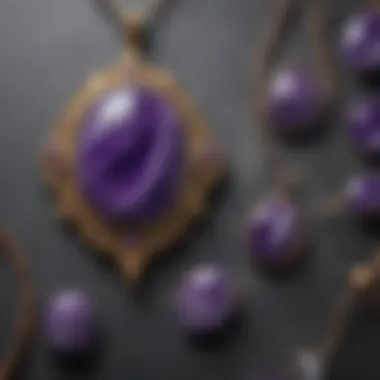
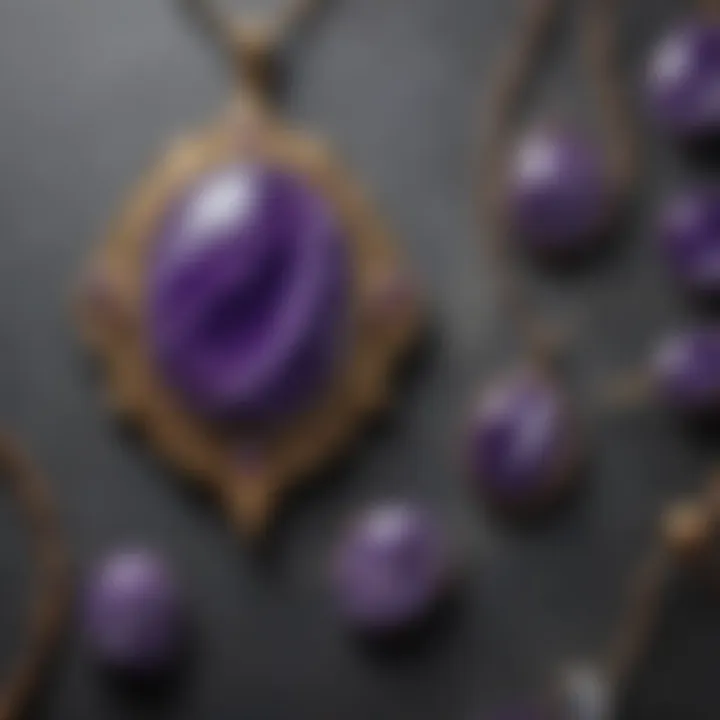
The naming process reflects both its origin and the beauty inherent in its structure. Since its discovery, charoite has been sought after for its unique aesthetic that cannot be found in many other minerals. The rarity of charoite makes it more desirable, leading to a surge in interest among those seeking to add it to their collections.
Cultural Significance
Charoite's cultural significance is profound. In Russia, charoite is often associated with healing properties and is thought to promote emotional stability. Collectors and enthusiasts value it not only for its beauty but for the stories connected to its origins. The cultural narrative around charoite highlights how it has been integrated into Russian folklore, believed to possess protective qualities.
The mineral's aesthetic appeal and rarity have contributed to its status as a symbol of luxury and sophistication in jewelry making. As designers embrace charoite in their creations, it becomes more than just a decorative piece; it becomes a representation of craft and culture.
Many collectors seek charoite for its aesthetic qualities as well as its historical and cultural background. This deep-rooted connection helps establish charoite's place not just in geology but in global culture.
Collectors should consider both the aesthetic and cultural narratives surrounding charoite, as these factors enhance its value and appeal.
Understanding the historical context of charoite cabochons elevates appreciation not just of the mineral but also of the interconnected world of gems and culture. This knowledge serves collectors and enthusiasts alike, guiding them in their quest for authentic and meaningful additions to their collections.
Current Market Trends for Charoite Cabochons
The evaluation of the current market trends for charoite cabochons is integral to understanding their value and potential as collectibles. Charotite has seen changes in popularity, availability, and pricing, driven by factors such as consumer interest, cultural significance, and the gem’s unique characteristics. Collectors and enthusiasts should be aware of these elements to make informed decisions when purchasing or selling charoite cabochons.
Pricing Insights
Pricing of charoite cabochons is influenced by several elements. First, the quality of the stone plays a crucial role. High-quality cabochons that display rich colors and distinct patterns command higher prices. The size of the cabochon also affects its price; larger pieces are generally more expensive. Market fluctuations can impact prices as well. For instance, heightened interest in a specific gemstone type can drive up prices due to demand outstripping supply.
Some recent trends indicate that charoite has seen a gradual increase in price over the past few years. However, prices can vary significantly between different retailers and platforms. Therefore, it is wise for collectors to compare prices from multiple sources before making purchases. Websites like reddit.com and gem marketplaces can provide valuable insights and guidance on current pricing trends.
Market Demand and Availability
The demand for charoite cabochons fluctuates based on several factors such as design trends in jewelry and personal preferences among collectors. In recent years, the appeal of genuine and unique gemstones has led to a growing interest in charoite. This mineral, with its striking appearance, meets the aesthetic preferences of many collectors.
In terms of availability, charoite can be somewhat limited. Found primarily in Yakutia, Russia, the extraction of charoite is a meticulous process. Not all sources yield high-quality material, and this scarcity can influence market dynamics. Consequently, collectors may find that sought-after pieces are difficult to obtain, which can elevate their status and value within the collector community.
"Understanding the nuances in pricing and availability can empower collectors, ensuring they make well-informed decisions on their investments."
Common Misconceptions about Charoite
The topic of misconceptions surrounding charoite is crucial in understanding this unique mineral better. As a collector or enthusiast, one must navigate the wealth of information available, which often includes inaccuracies and myths. These misconceptions can hinder appreciation and lead to uninformed purchasing decisions. Therefore, addressing and debunking these myths is not only informative but essential for fostering a deeper understanding of charoite and its attributes.
Myths Debunked
Many myths exist about charoite that can cause confusion among collectors.
- Charoite is a synthetic stone: One prevalent myth is that charoite is synthetic or man-made. In reality, charoite is a natural mineral found only in a limited area of Siberia, Russia. Its formation process is geological and complex, involving multiple minerals that create its distinct appearance.
- It has no value: Another common belief is that charoite lacks value compared to other gemstones. In truth, unique colors and patterns contribute to its desirability. As interest in charoite has grown, so too has its value in the market, making it a sought-after item for collectors.
- Charoite is always purple: While purple is the dominant color associated with charoite, it can also occur in various hues, including white, gray, or even black. This variation can sometimes lead to misidentification, but it also indicates the mineral's rich diversity.
Clarifying Misunderstandings
Misunderstandings about charoite can detract from a collector's experience. Some essential clarifications include:
- Chatoyancy and Asterism: Many assume that all charoite exhibits chatoyant or asterism effects. However, not all specimens will display these phenomena. Instead, these effects are dependent on the specific inclusions and structure of each cabochon.
- Care Techniques: There is a general belief that charoite is too delicate for everyday use. While it does require proper care, it is fairly durable. Regular cleaning with gentle methods can preserve its appearance.
"Misinformation may prevent enthusiasts from fully enjoying charoite's beauty and significance in the rock and mineral community."
- Healing Properties: Some collectors believe charoite possesses specific metaphysical properties or healing powers. While this belief is widespread among certain groups, these claims often rely on anecdotal evidence rather than empirical data.
In summary, addressing these misconceptions is critical. Having accurate knowledge can enhance appreciation for charoite and supports informed collecting. As collectors explore the realm of charoite, separating fact from fiction will empower them to make better choices and cultivate a genuine love for this remarkable mineral.
The End and Future Outlook
The exploration of charoite cabochons provides valuable insights into the mineral's fascinating characteristics and origins. As this article highlights, understanding these aspects enhances the appreciation for charoite, both as a collectible and as a material used in jewelry making. One of the significant elements discussed includes the importance of recognizing the geological formation of charoite. This forms the foundation for its unique properties, allowing collectors to make informed choices.
Sustaining interest in charoite cabochons is vital, especially in a market that constantly evolves. Collectors must remain aware of trends, pricing changes, and the availability of authentic pieces. Consequently, the article outlines key considerations and practical tips to support ongoing interest in this mineral.
Another crucial aspect is the evolving role of charoite in collecting. This mineral, once primarily appreciated for its aesthetic beauty, has gained importance among enthusiasts who value authenticity and provenance. As new collectors emerge, there will likely be an increase in enthusiasm for charoite cabochons, fostering a richer appreciation and understanding of this mineral. Such dynamics emphasize that charoite is not just a static addition to any collection but a living part of the mineral and gemstone narrative, worthy of attention and respect.
In summary, the future outlook for charoite cabochons remains promising. By continuing to share knowledge about its origins, properties, and care, collectors can secure a meaningful place for charoite in the realm of gemstones and collectibles. Awareness and education are fundamental to ensuring that this stunning mineral thrives in the years to come.
Sustaining Interest in Charoite
Keeping the interest in charoite vibrant requires more than just admiration for its beauty. Ongoing education and engagement with both new and seasoned collectors are essential. Here are key methods to sustain interest:
- Regular Literature Review: Stay updated with new books or articles focusing on charoite. This helps collectors deepen their knowledge.
- Workshops and Exhibitions: Participating in events allows collectors to interact with experts and fellow enthusiasts while experiencing the mineral firsthand.
- Online Communities: Engaging in forums such as Reddit or specialized Facebook groups can provide support and discussions. Sharing experiences helps maintain passion for charoite.
Ultimately, sustaining interest means integrating charoite into the broader context of mineral collecting.
The Evolving Role of Charoite in Collecting
The role of charoite within the collecting community is changing rapidly. Factors affecting this evolution include market trends and collector preferences. Here are some observations worth noting:
- Increasing Rarity: As more collectors seek high-quality pieces, authenticity becomes paramount. Understanding the nuances of charoite, such as identifying counterfeits, is essential for knowledgeable collecting.
- Valuing Provenance: Collectors are becoming more aware of the origins of their pieces, often seeking detailed backgrounds about the mineral. This not only enhances collection value but also supports ethical sourcing.
- Diversification of Uses: Beyond traditional jewelry, charoite is now sought for use in decor and custom pieces. This diversification can attract a broader audience to the collecting field.
The evolving role of charoite in collecting encapsulates not only its beauty but also its strategic importance in the broader mineral collection landscape.



